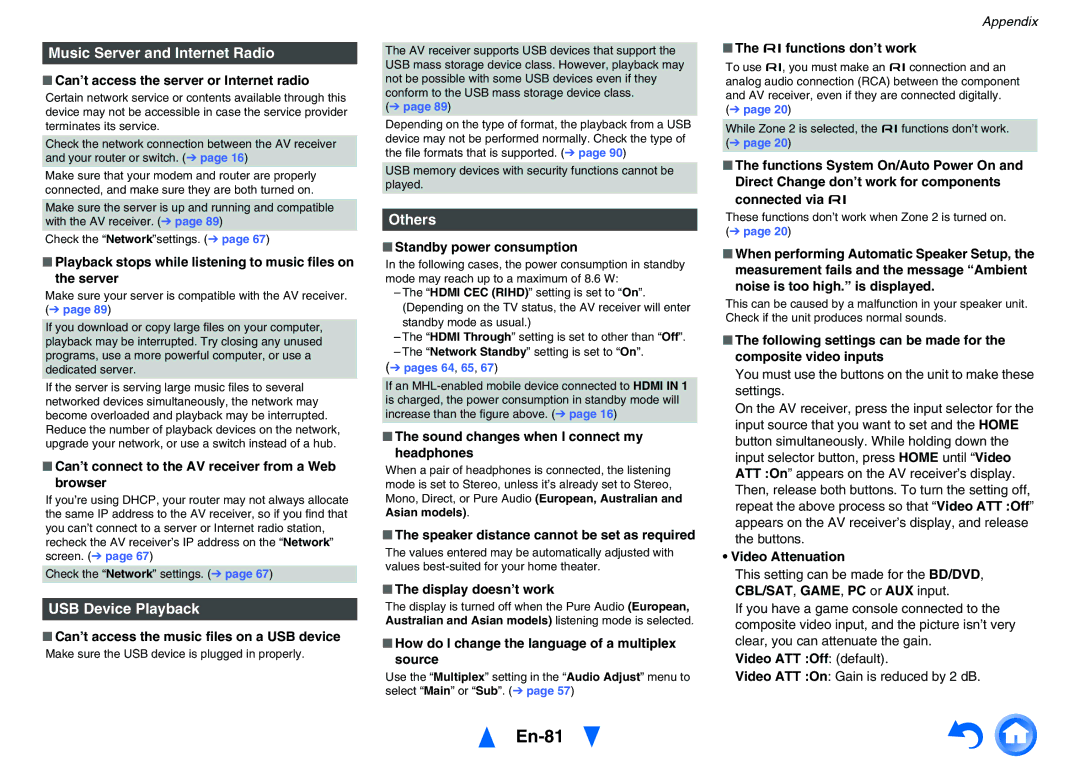TX-NR626
En-2
For U.S. and Canadian models
Precautions
En-3
FCC Caution
For Canadian Models
RF Exposure Compliance
Modèle pour les Canadien
For British models
Supplied Accessories
Make sure you have the following accessories
En-5
Table of Contents
En-7
Features
En-8
Front & Rear Panels
Front Panel
For detailed information, see the pages in parentheses
This lights when a 3D input signal is detected
Z2 Zone 2 indicator 3D indicator
En-9
Display
En-10
See Connecting Your Speakers for connection
Rear Panel
TV/CD IN, Phono
En-11
Remote Controller
Controlling the AV Receiver
Receiver
Connecting the AV Receiver
Connecting Your Speakers
En-12
En-13
Connecting the Speaker Cables/Powered Subwoofers
Back or Front High L terminals
Screw-type speaker terminals
En-14
Bi-amping the Front Speakers
Don’t connect one speaker to several terminals
Connecting the TV/AV components
En-15
Another TV can be connected to the Hdmi OUT SUB jack
En-16
Connecting to the Network Optional
About RIHD-compatible components
MHL Mobile High-Definition Link
Video and audio signal flow
Confirm the settings
En-17
Operations that can be performed with Rihd connection
En-18
AV Cables and Jacks
Hdmi
En-19
Connecting the Antennas
Connecting Onkyo RI Components
Using Headphones
En-20
Turning On/Off the AV Receiver
Connecting the Power Cord
En-21
Turning Off
En-22
Initial Setup
Terminating the Initial Setup
Remote Mode Setup
En-23
Source Connection
Measurement procedure
Using the Automatic Speaker Setup
En-24
First measurement position
Enter
En-25
Error Messages
Using a Powered Subwoofer
En-26
Performing Wireless LAN Setup
Automatic wireless LAN setup
En-27
En-28
Manual wireless LAN setup
En-29
Playback
En-30
Controlling Contents of USB or Network Devices
Playing an Audio from Bluetooth- enabled Device
En-31
Understanding Icons on the Display
En-32
Playing a USB Device
Listening to TuneIn
En-33
Setting an TuneIn account
En-34
Changing the Icon Layout on the Network Service Screen
Registering Other Internet Radio
Playing Music Files on a Server Dlna
Windows Media Player Setup
En-35
Playing music files on a server Dlna
En-36
Windows 8/Windows 7 Setup
Playing Music Files on a Shared Folder
Playing music files on a shared folder
Using Remote Playback
Windows Media Player 12 Setup
En-37
Remote Playback
Presetting AM/FM Stations
Using the Tuner
Tuning into Radio Stations
En-38
Using RDS excluding North American and Taiwanese models
En-39
Mode
Playing Audio and Video from Separate Sources
En-40
En-41
Using the Listening Modes
About Listening Modes
Selecting Listening Modes
Input Source
En-42
Speaker Layout
Onkyo-Original DSP Listening Modes
Listening Modes
En-43
En-44
En-45
Using the Sleep Timer
Displaying Source Information
Following information can be typically displayed
En-46
Setting the Display Brightness
Changing the Input Display
Muting the AV Receiver
Using the Home Menu
En-47
USB
On-screen Setup
Using the Quick Setup
En-48
Phase Matching Bass
Using the Audio Settings of Quick Setup
En-49
Explanatory Notes
Speaker Levels
En-50
Audyssey
Late Night
En-51
CinemaFILTER
Cinema Filter ` Off ` On
Using the Setup Menu Home
Setup Menu Items
En-52
En-53
Speaker Setup
Input/Output Assign
Monitor Out
Hdmi Input
En-54
Component Video Input
BD/DVD, CBL/SAT, GAME, PC, AUX, TV/CD Phono
Speaker Settings
Speaker Setup
En-55
Digital Audio Input
Speaker Distance
En-56
En-57
Audio Adjust
Level Calibration
Multiplex/Mono
Source Setup
Theater-Dimensional
En-58
En-59
En-60
IntelliVolume
Sync
Name Edit
En-61
Picture Adjust
Setting the Incoming Digital Signal Fixed Mode
En-62
Audio Selector
Volume Setup
Listening Mode Preset
En-63
Miscellaneous
OSD Setup
Hardware Setup
En-64
Tuner
` BD/DVD, CBL/SAT, GAME, PC, AUX, TV/CD Phono
En-65
Auto Standby
En-66
En-67
Network
Dhcp
Remote Controller Setup
Lock Setup
En-68
Connecting the Zone Speakers to an Additional Amplifier
Connecting Your Zone 2 Speakers Directly to the AV receiver
Zone
En-69
En-70
Adjusting the Volume for Zone
Controlling Zone 2 Components
Muting Zone
Looking up for Remote Control Codes
Preprogrammed Remote Control Codes
Entering Remote Control Codes
Controlling Other Components
Resetting the Remote Mode Buttons
Remote Control Codes for Onkyo Components Connected via RI
Resetting the Remote Controller
En-72
En-73
Controlling MHL-Enabled Mobile Device
Controlling Other Components
Controlling a TV
En-74
Using the Onkyo Dock
En-75
RI Dock
Controlling Your iPod/iPhone
En-76
With the RI Control
Without the RI Control
Resetting the AV receiver
Troubleshooting
Power
En-77
En-78
En-79
Remote Controller
Video
Tuner
Bluetooth
Wi-Fi Wireless LAN Network
En-80
RI Dock for iPod/iPhone
Music Server and Internet Radio
En-81
USB Device Playback
Others
Radio Wave Caution
En-82
Scope of Operation
Devices which use a 2.4 GHz radio wave frequency
Precautions
En-83
Radio Wave Reflections
En-84
Video Resolution Chart
Disclaimer
Output available
Update Procedure
Firmware Update
En-85
Updating the Firmware via Network
Errors during an update via network
Troubleshooting
En-86
Updating the Firmware via USB
En-87
En-88
About Hdmi
Supported Audio Formats
About Copyright Protection
En-89
Network/USB Features
Network Requirements
Server Requirements
En-90
Supported Audio File Formats
About Dlna
En-91
License and Trademark Information
En-92
Specifications
General
En-93
En-94
Memo
En-95
Hong Kong
Mainland
4 0 1 4 1 2 E N B
Using Internet Radio
Common Procedures in Internet Radio Menu
En-1
Getting Started U.S. only
Pandora internet radio
RANDOM, Repeat
Using Rhapsody U.S. only
Use q/wto select Sign In, and then press
Using the SiriusXM Internet Radio North American only
Use q/wto select the desired channel and then press Enter
Menu Items Add to My Favorites
Using Last.fm Internet Radio
Using Slacker Personal Radio
Using MP3tunes
Playing Contents on the AV Receiver
Creating an Account on your Computer
Utilisation d’une webradio
Fr-1
Procédures courantes dans le menu de webradio
Pour commencer États-Unis
Fr-2
Uniquement
Eléments du menu I like this track
Utilisation de Rhapsody Etats-Unis
Fr-3
Fr-4
Eléments du menu Add to My Favorites
Permet d’ajouter un canal à la liste My Favorites
Utilisation de la webradio Last.fm
Fr-5
Fr-6
Touches sur la télécommande
Utilisation de Slacker Personal Radio
Vous pouvez contrôlez les pistes avec les
Uso de Internet Radio
Es-1
Procedimientos comunes en el menú Internet Radio
Primeros pasos solo EE.UU
Es-2
Uso de Rhapsody sólo EE.UU
Es-3
Uso de SiriusXM Internet Radio solo Norteamérica
Es-4
Utilice q/wpara seleccionar Sign In, y luego pulse Enter
Elementos del menú Add to My Favorites
Uso de Last.fm Internet Radio
Es-5
Last.fm es un servicio musical que sabe lo que le Gusta
Elementos del menú I Love this track
Uso de Slacker Personal Radio
Es-6
4 0 1 4 7 8 I R U S
Using Internet Radio
En-2
De-1
Internetradio verwenden
Allgemeine Verfahren bei den Internetradio-Menüs
Drücken Sie NET
Verwendung von Last.fm Internet Radio
Menüsymbole I Love this track
Verwendung der Tastaturanzeige
Scrobbling-Steuerung verwenden
Remote Control Codes
Códigos de control remoto
Codes de télécommande
Fernbedienungscodes
Codici del telecomando
Fjärrstyrningskoder
Afstandsbedieningscodes
遥控代码
Cable Set Top Box
Cable/PVR Combination
IPTV/PVR Combination
Accessory
CD/Cassette Dock
Cassette Deck
Satellite Set Top Box
Video Accessory
ITT
HTS
Neotion
NPG
Television
SAT/PVR Combination
ART
AOC
ATD
BPL
GFM
GEC
GVA
HCM
MEI
LXI
MGA
MTC
SBR
RFT
SEI
SLX
TV/VCR Combination
GPX
Asda
MDS
REC
TVE
Blu-ray Disc
TV/DVD Combination
Crown 11037 DMTech 12001 Dual Dynex 12049 Elfunk Emerson
Memo
4 0 1 4 7 1 code

